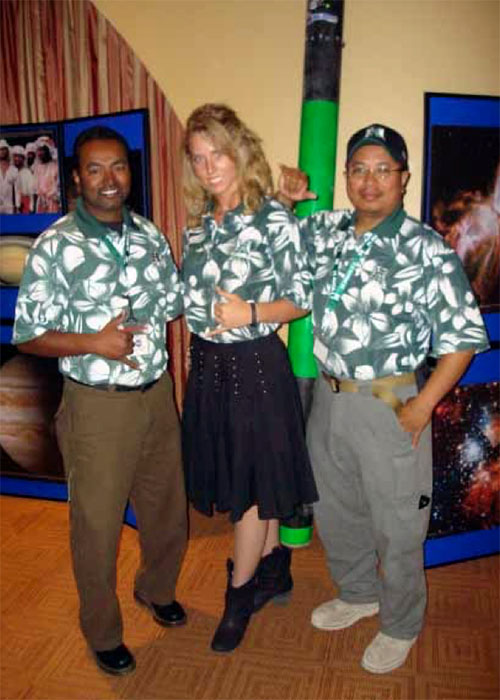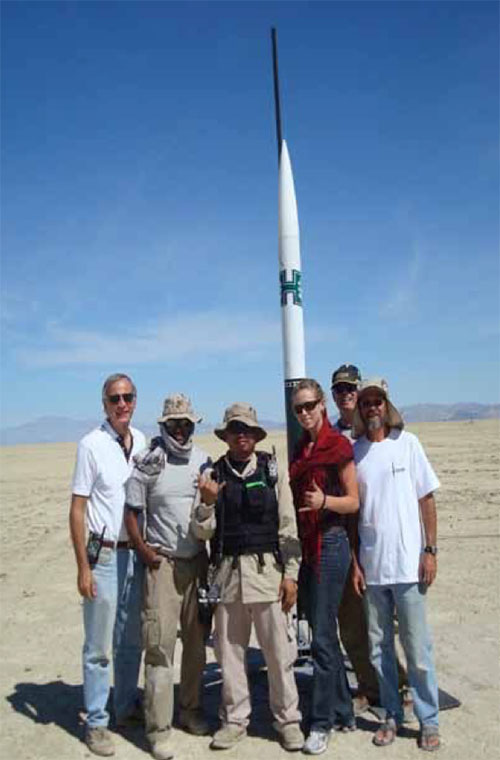Windward Community College in ARLISS & USLI by: Premo Ames II
WCC Student, ARLISS 2009 Project Manager
Na Huakai Vol. 3 Winter 2010
Sponsored by the Hawai‘i Space Grant Consortium (HSGC), Windward Community College ( WCC) competed in its fourth year of A Rocket Launch for International Student Satellites (ARLISS) CanSat competition. The 2009 ARLISS team included Premo Ames II, Joleen Iwaniec, Todd Esposito, and Makana Ciotti. Mentors include Joseph Ciotti and Jacob Hudson from WCC, and Helen Rapozo from Honolulu Community College (HCC). Titled “Holomua – Moving Forward,” the project centered on redesigning the CanSat body from the previous year, which allowed for several improvements.
The redesign entailed enlarging the CanSat housing to maximize interior space for the new, updated electronics and parafoil. Enlargement of the parafoil ejection chamber also allowed for a smoother and consistent deployment. The CanSat module was also manufactured in carbon fiber, which decreased weight while increasing capacity.

Weight saved from the body was replaced by new electronics. As in the previous design, electronics were separated into three parallel systems so that if one system failed the others
would still operate. The three separate systems were navigation, data collection, and parafoil deployment. Additionally each system had a redundant data acquisition function.
The navigation system is the most critical of all the systems as it is the brains of the module telling it where it is, and what direction it needs to steer to. The navigation system consisted of a Parallax Propeller microcontroller and GPS unit using the Spin programming language. The Prop chip was designed to send signals to the Parallax servo unit, turning it one way or another, depending on the degree off- axis from the target destination the Prop chip calculated. Passenger Board 2 (PB2) was designed to collect location, altitude, date, and time from the GPS system and the internal temperature of the Holomua CanSat and store it on memory chip and transmit some of the information to a ground station via a radio link.
The final system comprised of a G-Wiz HCX flight computer. The decision to use an off-the- shelf flight computer was made to ensure deployment of the parafoil. The HCX model was chosen because of its flexibility and ability to capture flight data.
Flight testing of individual systems was done on the Kāne‘ohe Marine Corps Air Station. Full- scale testing was not possible due to limited land space availability. Nevertheless, Holomua was successful, landing within 0.25 miles from the target at ARLISS 2009. To carry on the success for 2010 Todd Esposito will be joined by Patrick Lancaster and Jasmine Maru.

(left to right) Dr. Joseph Ciotti, Todd Esposito, Premo Ames, Joleen Iwaniec
Rocket team at the 2009 ARLISS competition in Black Rock, NV
The success of WCC’s ARLISS program has led to a new competition, University Student Launch Initiative (USLI). WCC’s USLI team, Premo Ames II, Joleen Iwaniec, and Todd Esposito, with help from this year’s ARLISS team has completed the first hurdle of the competition by having their USLI proposal accepted by NASA Marshal Space Flight Center (MSFC). Students are tasked with building and launching a rocket closest to a mile high, but the real competition is the actual procedure NASA uses for projects. Reports, sourcing, purchasing materials, managing finances, building, testing, educational outreach and website presence, present individual challenges to the students. With a multitude of reports, missing a deadline can mean disqualification.


